9 Reproduction
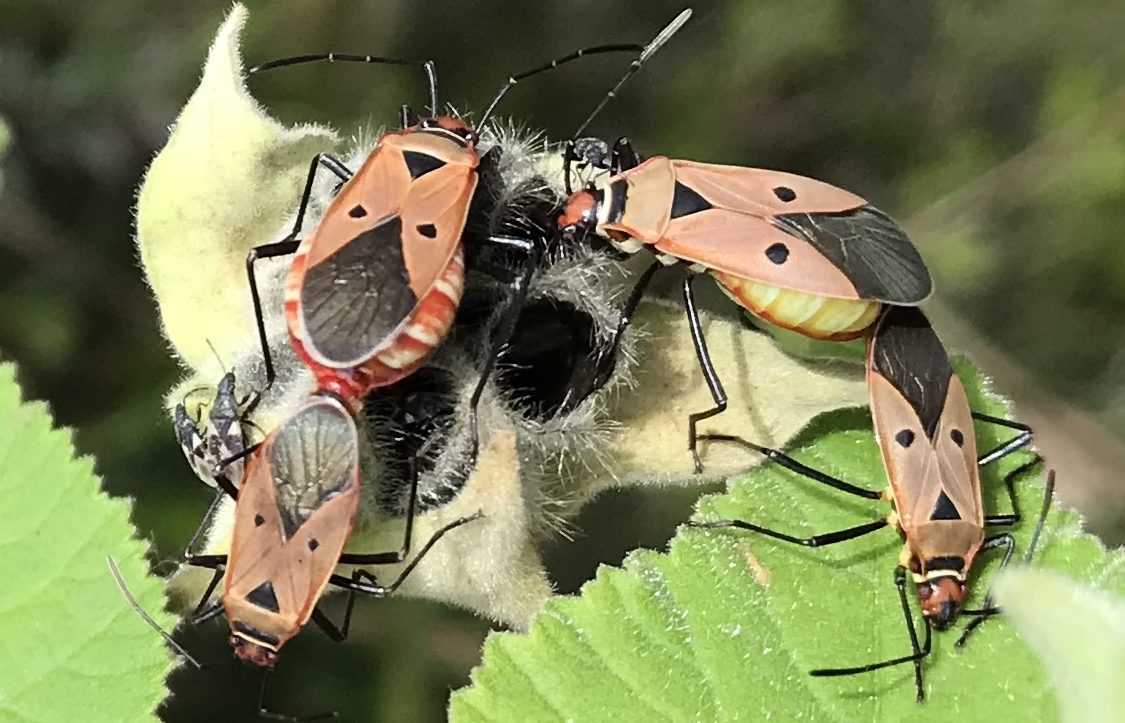
Insects’ reproductive methods are diverse. We examine the internal morphology of male and female reproductive systems. A feature of insects is that the females store sperm so that they can fertilise their eggs “on demand” without a male being in the vicinity. Insects can be live-bearers or egg-layers.
Learning Objectives
- Be familiar with the structure of the ground-plan male and female reproductive systems
- Be familiar with the variety of mating strategies used by insects
- Understand how egg fertilisation occurs and know the main sex determination mechanisms
- Know the difference between oviparity, ovoviviparity and viviparity
Reproductive Systems of Male and Female
THRD0023 027 (YouTube, 2m 39s):
Male Reproductive System
The significant components are the testes, vas deferens, male accessory glands, seminal vesicles, ejaculatory duct and intromittent organ, also known as aedeagus or penis.
The paired testes are bilateral, sometimes fused at the midline. The germ cells are maintained in the testes and they divide many times to produce sperm. Active sperm are stored in the vas deferens. In some cases, the males have a sperm pump that helps force sperm into the female during mating. Spermatozoan morphology is diverse across the insects and has been used as a phylogenetic character, i.e. telling us which taxa are related.
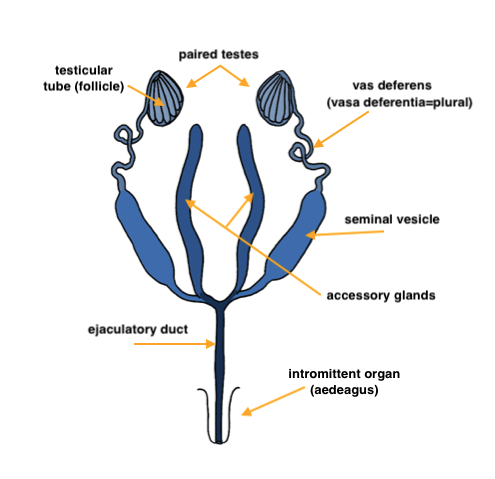
Female Reproductive System
The significant components are the ovarioles, lateral oviducts, common oviduct, female accessory glands, spermathecae and their associated glands, and vagina (bursa copulatrix).
The ovaries are paired, located in the posterior abdomen. In some insects, the ovaries can occupy a large volume of the abdomen in gravid (ready to oviposit) females. Each ovary is composed of many ovarioles, the units that each produce an egg. A single lateral oviduct runs from each ovary and joins a common muscle-lined oviduct. Frequently it has a muscular expansion called the bursa copulatrix. The bursa copulatrix can have a role in mating—receiving the aedeagus and secretions from the male (spermatophore, spermatozoa, accessory gland secretions)—and/or a role in oviposition; it is the site of egg fertilisation and coating the eggs with female accessory gland secretions.
Generally, one or more pairs of accessory glands open into the bursa copulatrix or common oviduct. The accessory glands often secrete an adhesive which coats the eggs to stick them together or to the substrate. Glands with this function are called colleterial glands. In cockroaches and mantids, the accessory gland secretion forms a hard coat around the egg batch. Mantids create a froth from the secretion that hardens around the eggs. In these cases the eggs are said to be contained within an ootheca (=egg case). In tsetse flies the accessory glands form milk glands that produce a nutritive secretion for the larva that is developing in the uterus.
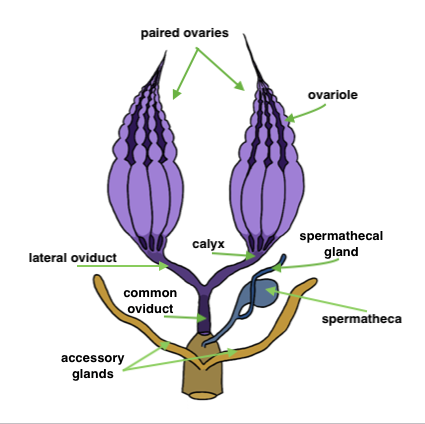
Insemination
THRD0023 028 (YouTube, 4m 56s):
Some species inject sperm directly during the act of copulation. Others produce a spermatophore, a package of sperm that is deposited on the external environment, or on the female’s external genitalia (Mormon cricket) or into the female’s bursa. It is regarded as an ancestral condition. It is used in myriapods, collembolan and silverfish, perhaps related to terrestrialisation because it may be the first step in transitioning from fertilisation in an aquatic environment to a terrestrial environment.
Spermathecae
Spermathecae are the sperm storage organs within the female. Females generally have 1-3 spermathecae. Sperm can remain viable for years. In some cases such as queen bees, sperm storage creates the interesting scenario where long-dead males can keep producing progeny.
Spermathecae are frequently lined with sclerotised cuticle, perhaps to protect sperm from UV radiation. Spermathecae are often surrounded by dermal glands or have an adjacent spermathecal gland. It is most likely that the dermal gland products provide nutrient for the sperm, although they may play a role in aiding spermathecal filling.
The spermathecal ducts are often very narrow, and the spermathecae are bulbous. The number of spermathecae varies among insects. View this video (YouTube, 09s) of fluorescently tagged sperm moving within the female reproductive tract of Drosophila.
The Spermatophore
The spermatophore (Greek, sperma = seed; pherein = to carry) is a container that protects, envelops and transfers spermatozoa from the male to the female.
The male silverfish deposits a spermatophore surrounded by silk lines and leads the female to it. She contacts the silk thread and takes the spermatophore into her genital chamber. In some cases, the spermatophore provides nourishment to the female, i.e. it is a nuptial gift. The male thereby increases the likelihood that the progeny will survive.
Reproduction and Nutrition
Females need protein to develop eggs. In some insects, the eggs have already developed on reaching adult stage. The juveniles have stored sufficient lipid, protein and carbohydrate for the eggs to fully develop. In others, the female seeks a special diet, often protein-rich to allow egg development, for example, in mosquito females. In some fly species the males wrap a prey item with silk as a ‘nuptial gift’, providing an additional protein source for the female.
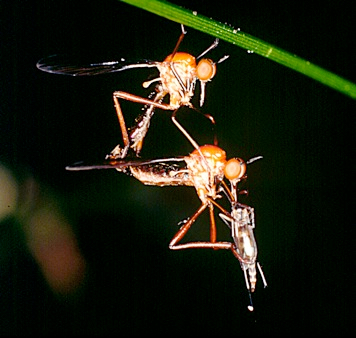
Keen to learn more?
In some species of Dance Flies (Diptera: Empididae), the males usually capture a small insect, then wrap it up in silk to present to the female as a protein-rich nuptial gift. To learn more about the behaviour and the interesting silk glands of these insects:
Young, J.H. & Merritt, D.J. 2003. The ultrastructure and function of the silk-producing basitarsus in the Hilarini (Diptera: Empididae). Arthropod Structure & Development 32: 157-165
Finding Mates
Swarming is a behavioural trait that is usually associated with mate selection. It is common in Ephemeroptera, midges (Diptera) and some Lepidoptera. Some fireflies accumulate in trees and the males flash in synchrony to attract females.
Lekking is a behaviour where males hold territories, e.g. some fruit-flies create leks.
Hill-topping is a behaviour that is common in higher flies where males and females accumulate at the tops of hills. Mating at oviposition or feeding sites is common in higher flies. The sensory signals that are used to find feeding or oviposition sites also serve to bring the two sexes together.
Copulation
THRD0023 029 (YouTube, 4m 18s):
It is to the male’s advantage to prevent females copulating afterwards so there is much evidence of “arms races” between males and females: males attempting to ensure their parenthood and females attempting to ensure the quality of the male.
In Drosophila, a “sex peptide” produced in the male accessory glands binds to sperm tails and is carried into the female to increase egg-lay and decrease receptivity. The carriage of the sex peptide on the sperm is the suggested reason for extra-ordinarily long sperm tails in some Drosophila spp (a 3 mm long male of Drosophila bifurca has sperm tail length of 58 mm).
Male dragonflies have barbed structures on the aedeagus whose role is to withdraw foregoing males’ sperm from within the female.
In Lucilia cuprina (the Australian sheep blowfly), males have evolved structures on the aedeagus to deliver accessory gland fluid (AF) into receptacles in the female bursa copulatrix. The AF causes the female to become unreceptive to any further mating attempts for a long period. Paired barbs on either side of terminal opening tear into the cuticle lining the internal female tract and release accessory gland fluid.
Fertilisation
Eggs are fertilised as they pass through the oviduct and vagina. Frequently the egg rests momentarily in the bursa copulatrix near the spermathecal duct opening into the bursa. Sperm are released from spermathecae or other storage organs and enter the egg through the micropyles: microscopic holes in the egg.
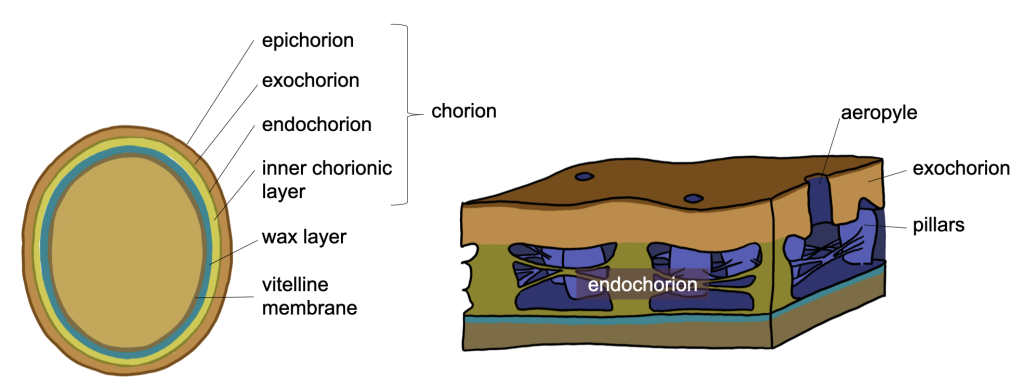
Keen to know a bit more detail about the insect egg? Check out this website.
Sex Determination
In most insects, both sexes are diploid. In Drosophila, males are X/Y and females are X/X, just like humans. There is a variety of sex chromosome mechanisms, based on diploidy.
Haplodiploidy
In haplodiploid sex determination, males have one set of chromosomes. One way is for the female not to fertilise the egg to make males (arrhenotoky). Consequently females are derived from fertilised eggs and males from unfertilised eggs. This is common in Hymenoptera. In honeybees, all workers are female as they are derived from fertilised eggs. Just a few males (drones) are produced from unfertilised eggs
In some insects, the paternal genome is eliminated from males after fertilisation occurs. This occurs in scale insects.
Egg-laying or Live-bearing
THRD0023 030 (YouTube, 4m 33s):
Oviparity
Most insects are oviparous, i.e. they lay eggs (oviposit). Among insects there is an extraordinary array of strategies of oviposition. The female is frequently very choosy in where to lay eggs because of the risks associated with web predation and parasitism by wasps.
Eggs can be laid singly or in batches. Eggs can be stuck together through coating from colleterial glands (accessory glands). Some insects protect the eggs through guarding by the female. This is frequently seen in bugs (Hemiptera) where the female sits atop the egg batch. Often, females lay eggs in, on or near suitable food. For close up videos of insect oviposition and egg-protection behaviour go to the UQ library catalog to find close-ups of insect behaviour [videorecordings] at this link: Insect Oviposition.
A honeybee, Apis mellifera queen produces about 220,000 eggs during a 12 month period i.e. 602 eggs per day, 25 eggs per hour. The termite Kalotermes flavicollis is estimated to lay 10 million eggs per year, an incredible 27,400 eggs per day. The embryonic development period varies greatly among insects, for example, embryos may develop quickly and eggs may hatch soon (<24 h in blowflies) to utilise ephemeral resources (e.g. fruit, carrion). At the other extreme, stick insect eggs are cast off by the female to fall into the leaf litter. They take many months to hatch.
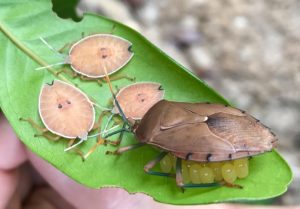
Oviviviparity
In this situation, fertilized eggs are held within female and the eggs hatch immediately on being deposited. It occurs in some flies, cockroaches, aphids and scale insects.
Viviparity
Viviparity means live-bearing. Embryonic development is completed within the female so that the larvae are active as soon as they are deposited. Various forms:
In the most extreme cases, larvae feed on secretions within female tract and pupate immediately after being deposited. The complete larval phase occurs within the female. Obviously, females can produce only a few offspring in their lifetime using this approach. It is found in tsetse flies and batflies among others.
Activities
Activity 9.1
Watch these 3 videos on oviposition or larva position:
- tsetse fly birth (YouTube, 4m 55s)
- Fly laying eggs (YouTube, 6m 54s)
- Cockroach eggs hatching (YouTube, 4m 15s)
Activity 9.2
Which of the following terms in the table apply to the male or female reproductive systems and what is the function of the structure?
| Term | M | F | Function |
|---|---|---|---|
| Ovaries | |||
| Vas deferens | |||
| Seminal vesicle | |||
| Bursa copulatrix | |||
| Accessory glands | |||
| Oviduct | |||
| Spermatheca | |||
| Gonopore | |||
| Testes |
Activity 9.3
Suggest a reason why: (1) eggs are stalked and (2) eggs are laid in clusters.
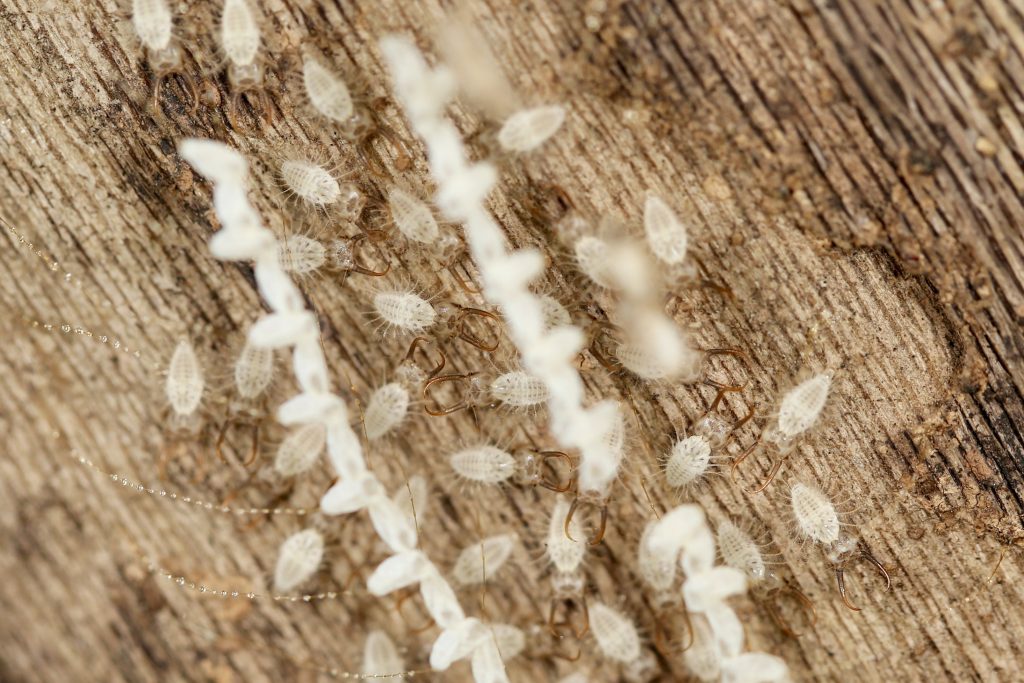
Topic Review
Do you know…?
- The structure of the generalised male and female reproductive systems
- The function of spermatophores and spermathecae
- The mechanism of sex determination in the Hymenoptera
- The difference between oviparity, ovoviviparity and viviparity.
Can you…?
- Draw and label the main components of the male and female reproductive systems?

